Mexico’s typical food is a vibrant tapestry of flavors, colors, and textures, deeply rooted in history and tradition, and at gaymexico.net, we celebrate its richness for the LGBTQ+ traveler seeking authentic experiences. From savory street tacos to complex mole sauces, Mexican cuisine offers something for everyone and ensures a memorable adventure. Let’s embark on a culinary exploration and discover the dishes that define Mexico’s gastronomic identity and offer tips for LGBTQ+ travelers looking to savor the best of Mexican cuisine.
1. Chilaquiles: A Breakfast Staple
Are you craving a hearty and flavorful Mexican breakfast? Chilaquiles are your answer! This popular traditional breakfast dish features lightly fried corn tortillas cut into quarters and topped with green or red salsa (the red is slightly spicier). Scrambled or fried eggs and pulled chicken are usually added on top, as well as cheese and cream. Chilaquiles are often served with a healthy dose of frijoles (refried beans).
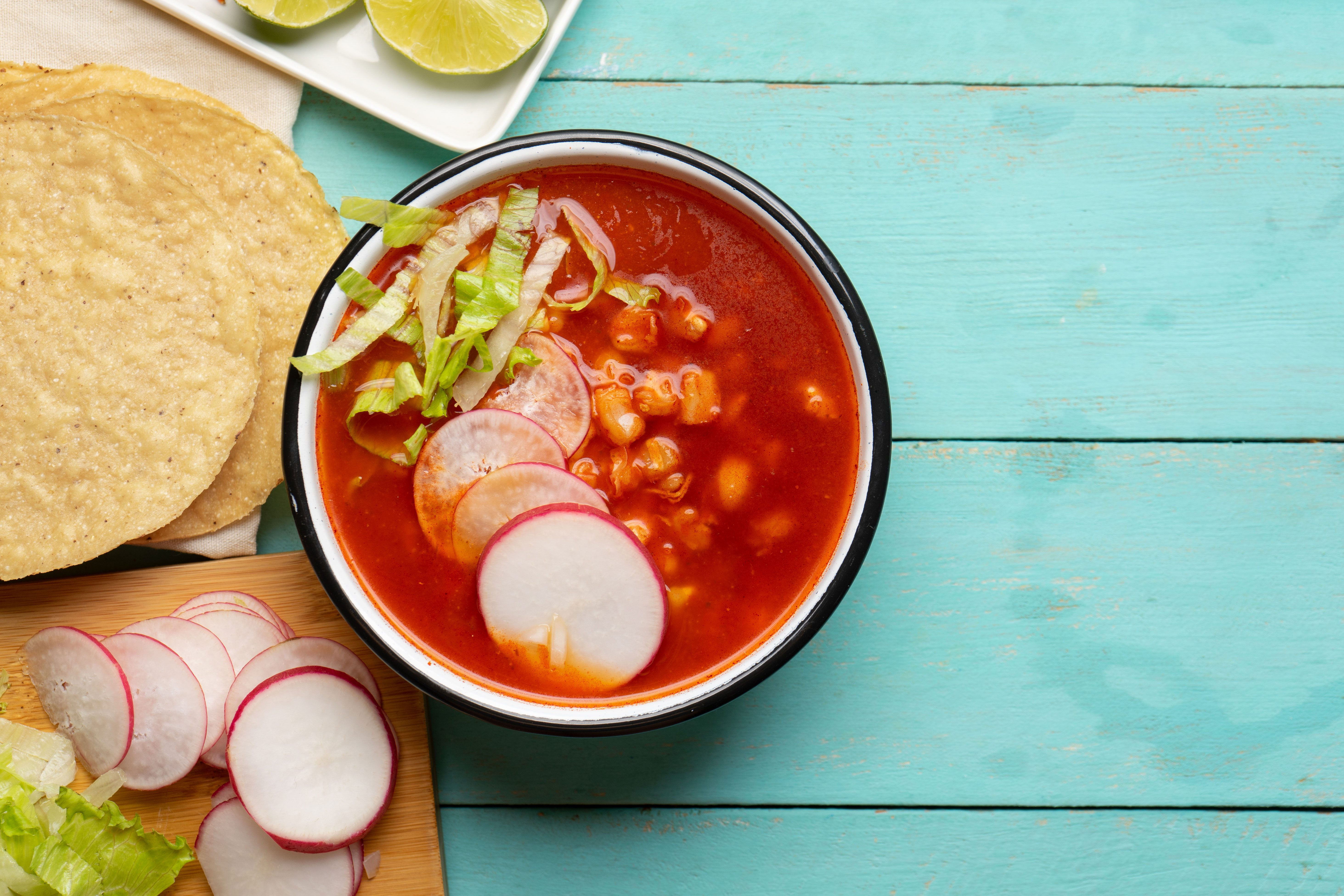 Chilaquiles with red sauce, cheese, and eggs
Chilaquiles with red sauce, cheese, and eggs
Chilaquiles represent the ingenuity of Mexican cuisine, transforming simple ingredients into a satisfying and flavorful meal. The dish’s versatility allows for countless variations, catering to diverse tastes and dietary preferences. Whether you prefer a tangy green salsa or a fiery red one, chilaquiles offer a comforting and authentic taste of Mexico. This is a great start to your day as an LGBTQ+ traveler exploring Mexico City or Puerto Vallarta.
2. Pozole: A Soul-Warming Soup
Want to experience a soup with deep cultural roots and rich flavors? Pozole is the perfect dish! According to anthropologists, this pre-Hispanic soup was once used as part of ritual sacrifices. These days chicken, pork and vegetarian pozole versions are readily available in more everyday surroundings. Made from hominy corn with plenty of herbs and spices, the dish is traditionally stewed for hours, often overnight. Once it’s ready to serve, lettuce, radish, onion, lime and chilli are sprinkled on top.
Pozole’s history adds an intriguing layer to its appeal. While its origins may be steeped in ancient rituals, today’s pozole is a celebration of flavor and community. The long simmering process allows the ingredients to meld together, creating a complex and satisfying broth. Each spoonful is a journey through Mexico’s culinary heritage.
3. Tacos al Pastor: A Culinary Fusion
Looking for a taco experience that blends tradition with international influences? Tacos al pastor are a must-try! This historic dish is one of the most popular varieties of tacos, with origins dating back to the 1920s and 30s and the arrival of Lebanese and Syrian immigrants to Mexico. To create tacos al pastor (meaning ‘in the style of the shepherd’), thin strips of pork are sliced off a spit, placed on a corn tortilla and served with onions, coriander leaves and pineapple.
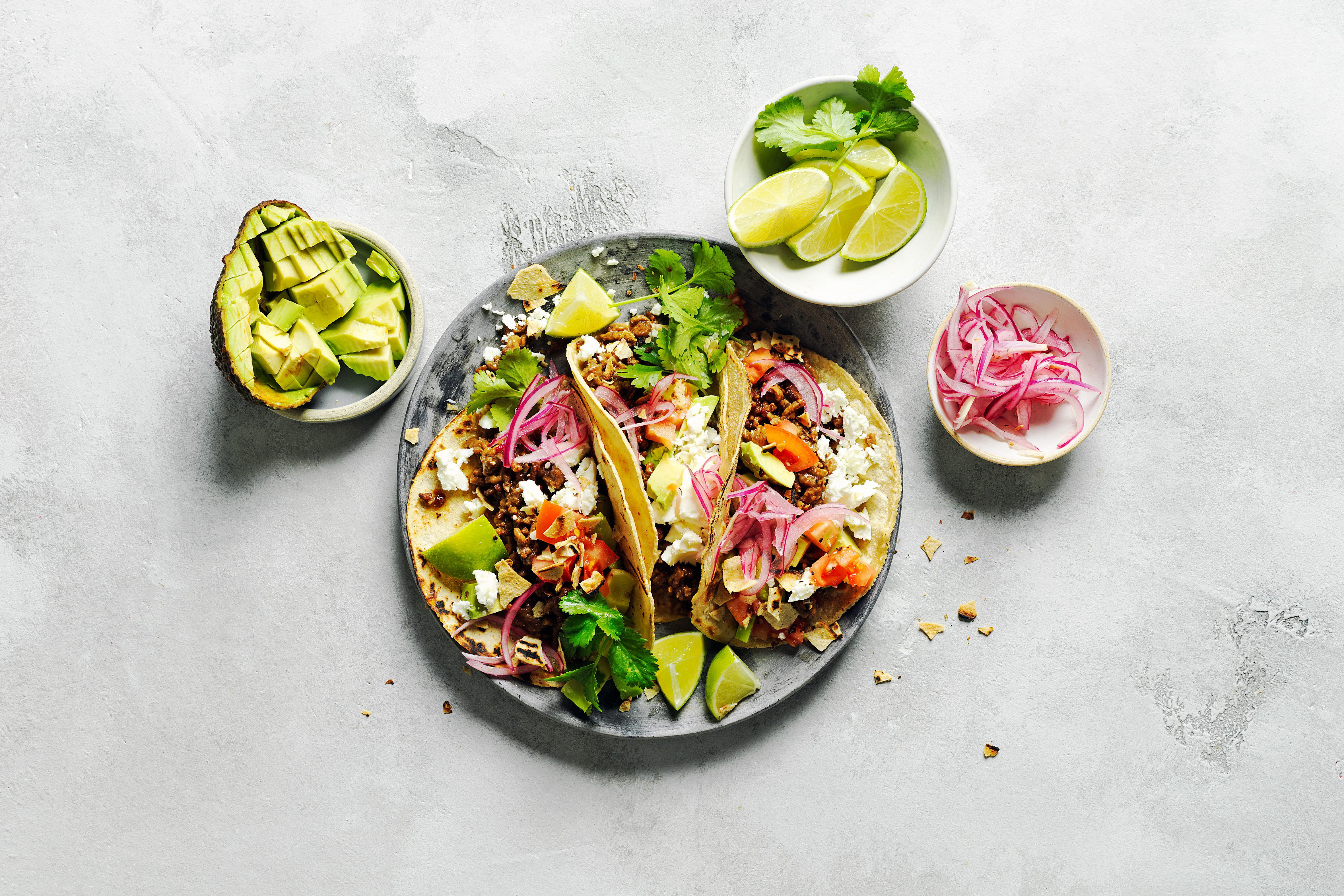 Tacos al pastor with pineapple, cilantro, and onions
Tacos al pastor with pineapple, cilantro, and onions
Tacos al pastor showcase the beauty of cultural exchange. The technique of cooking meat on a vertical spit was brought to Mexico by Lebanese immigrants, and the dish evolved to incorporate local flavors and ingredients. The result is a taco that is both familiar and unique, a testament to Mexico’s ability to embrace and adapt culinary traditions. This is a great bite while enjoying the nightlife in Guadalajara!
4. Tostadas: Crispy and Customizable
What to do with stale tortillas? Why, fry them of course! Literally meaning toasted, tostadas are a simple but delicious dish involving corn tortillas fried in boiling oil until they become crunchy and golden. These are then served alone or piled high with any number of garnishes. Popular toppings include frijoles (refried beans), cheese, cooked meat, seafood and ceviche.
Tostadas are a blank canvas for culinary creativity. Their crispy base provides the perfect foundation for a variety of toppings, allowing you to create a dish that suits your individual taste. Whether you prefer a vegetarian version with beans and avocado or a seafood-laden tostada with ceviche, the possibilities are endless.
5. Chiles en Nogada: A Patriotic Dish
Want to taste a dish that embodies the colors and spirit of Mexico? Chiles en nogada is one of Mexico’s most patriotic dishes. Poblano chillies filled with picadillo (a mixture of chopped meat, fruits and spices) represent the green on the flag, the walnut-based cream sauce is the white and pomegranate seeds are the red. Originating from Puebla, history relates that the dish was first served to Don Agustín de Iturbide, liberator and subsequent emperor of Mexico.
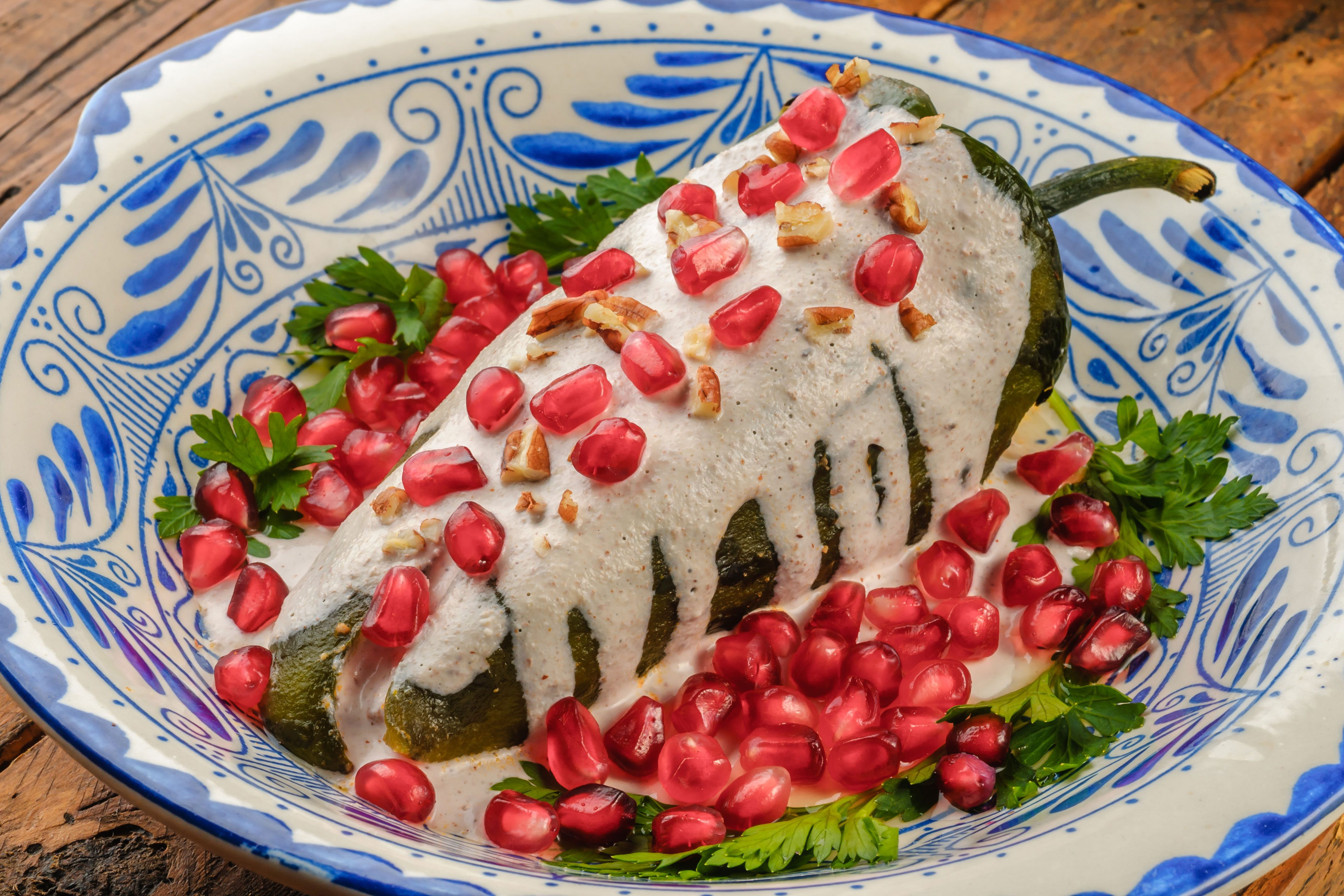 Chiles en nogada with walnut sauce and pomegranate seeds
Chiles en nogada with walnut sauce and pomegranate seeds
Chiles en nogada is more than just a meal; it’s a symbol of Mexican independence and culinary artistry. The combination of sweet and savory flavors, along with the dish’s vibrant colors, makes it a feast for the senses. Served primarily during the months of August and September, coinciding with Mexico’s Independence Day celebrations, chiles en nogada offers a taste of history and national pride.
6. Elote: A Street Food Delight
Craving a classic Mexican street food experience? You’ll find someone selling elote, the Mexican name for corn on the cob, on nearly every city street corner in Mexico. The corn is traditionally boiled and served either on a stick (to be eaten like an ice cream) or in cups, the kernels having been cut off the cob. Salt, chilli powder, lime, butter, cheese, mayonnaise and sour cream are then added in abundance.
Elote is a testament to the simple pleasures of Mexican street food. The combination of sweet corn, savory toppings, and a hint of spice is irresistible. Whether you prefer it on a stick or in a cup, elote is a must-try for anyone looking to experience the authentic flavors of Mexico.
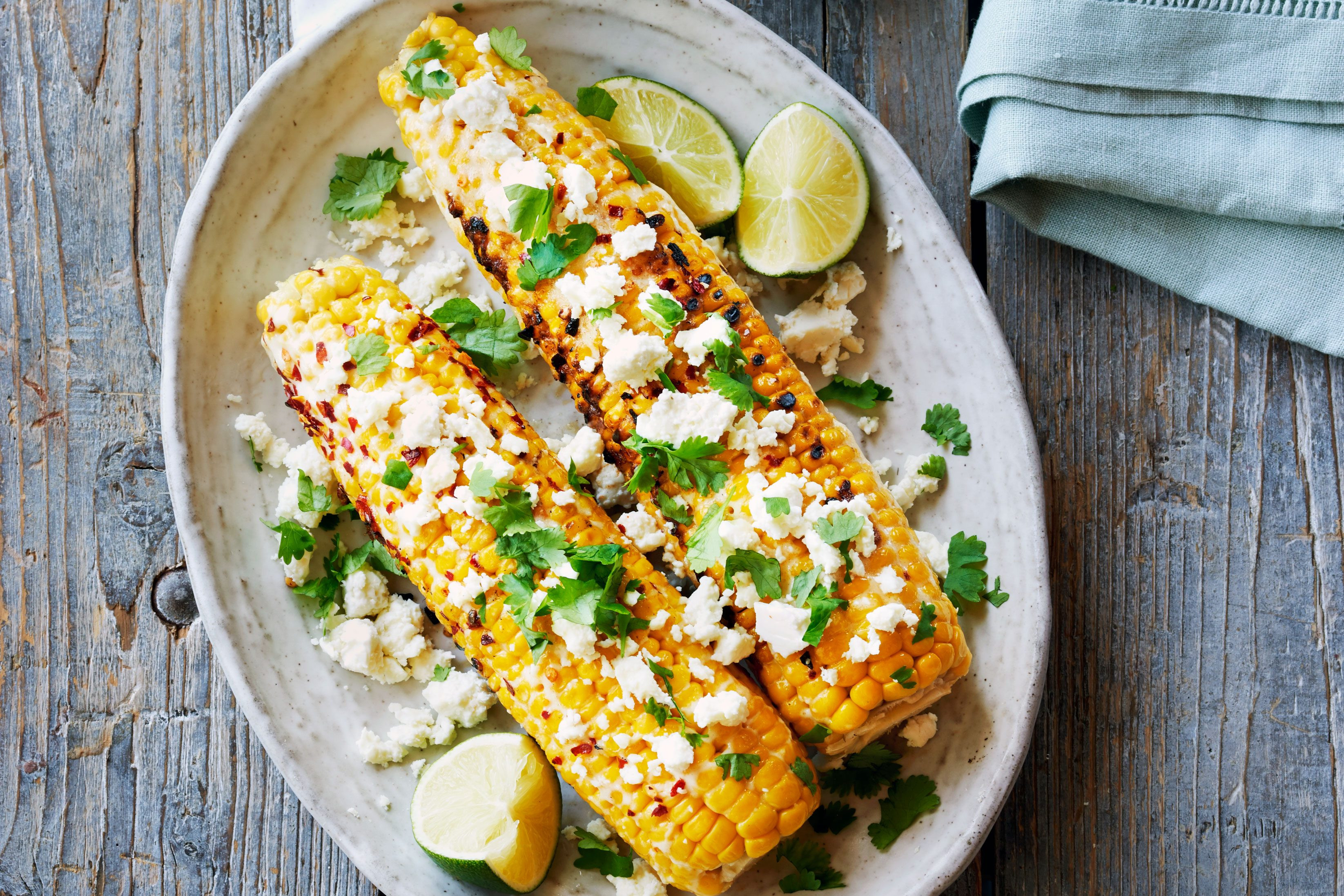 Grilled corn with chili mayonnaise, coriander and feta
Grilled corn with chili mayonnaise, coriander and feta
7. Enchiladas: A Versatile Classic
Enchiladas date back to Mayan times, when people in the Valley of Mexico would eat corn tortillas wrapped around small fish. These days both corn and flour tortillas are used and are filled with meat, cheese, seafood, beans, vegetables or all of the above. The stuffed tortillas are then covered in a chilli sauce, making for a perfect Mexican breakfast.
Enchiladas have evolved over centuries to become a staple of Mexican cuisine. Their versatility allows for endless variations, with fillings and sauces that cater to diverse tastes. Whether you prefer a simple cheese enchilada or a more elaborate version with meat and vegetables, enchiladas offer a comforting and satisfying meal.
8. Mole: A Complex Sauce
Three states claim to be the original home of mole (pronounced ‘mol-eh’), a rich sauce popular in Mexican cooking. There are myriad types of mole but all contain around 20 or so ingredients, including one or more varieties of chilli peppers, and all require constant stirring over a long period of time. Perhaps the best-known mole is mole poblano, a rusty red sauce typically served over turkey or chicken.
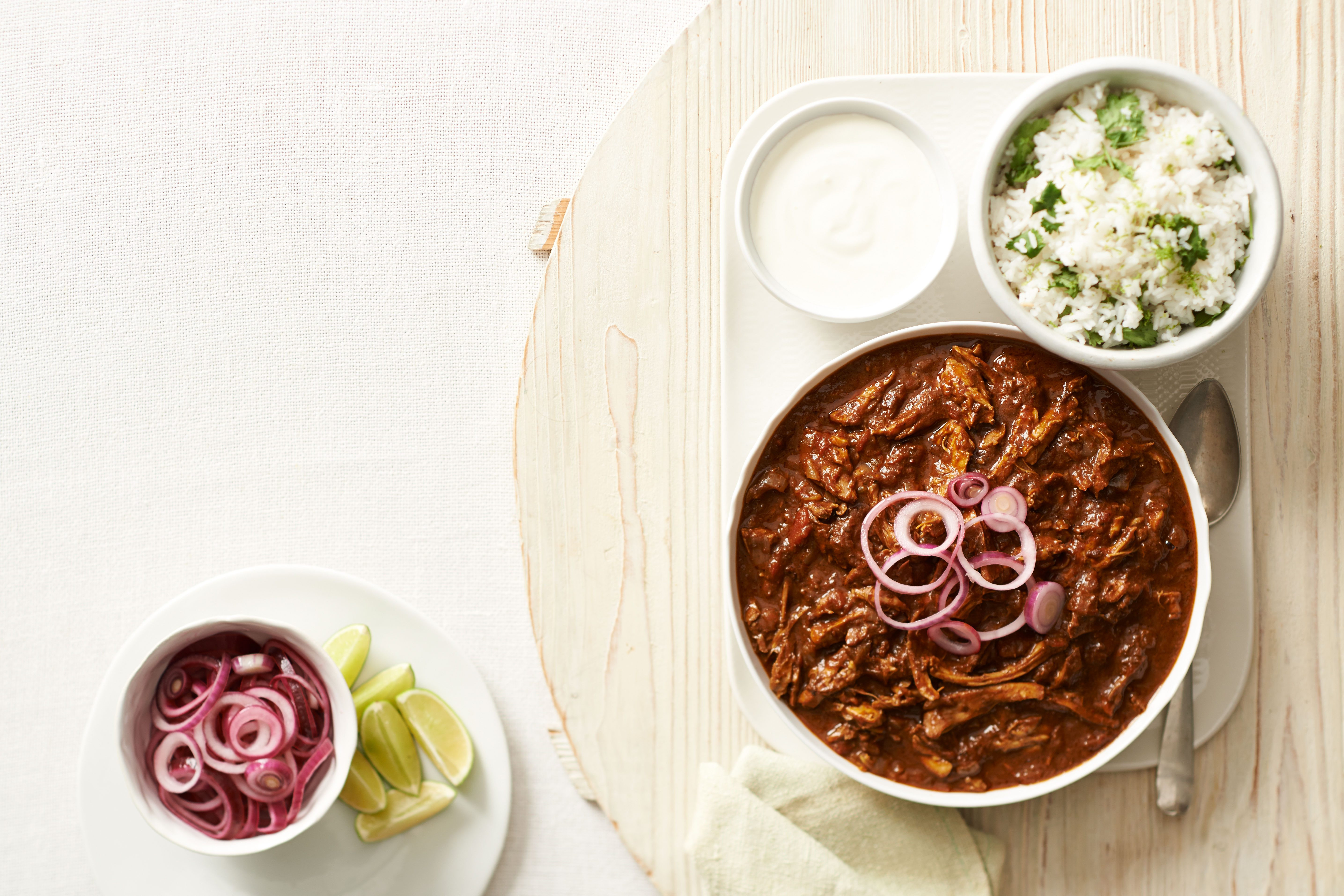 Chicken mole with coriander rice
Chicken mole with coriander rice
Mole is a testament to the dedication and artistry of Mexican cooks. The complex sauce requires hours of preparation and constant attention, but the result is a flavor that is both rich and unforgettable. Each type of mole offers a unique combination of ingredients and flavors, reflecting the diverse culinary traditions of Mexico.
9. Guacamole: An Ancient Dip
Guacamole is undoubtedly one of Mexico’s most popular dishes, but few people know that this traditional sauce dates back to the time of the Aztecs. Made from mashed-up avocados, onions, tomatoes, lemon juice and chilli peppers (and sometimes a clove or two of garlic), guacamole is often eaten with tortilla chips or used as a side dish.
Guacamole’s enduring popularity is a testament to its simple yet irresistible flavor. The creamy avocados, combined with the tangy lime juice and spicy chilli peppers, create a dip that is both refreshing and satisfying. Whether you enjoy it with tortilla chips or as a topping for your favorite Mexican dish, guacamole is a must-have for any Mexican meal.
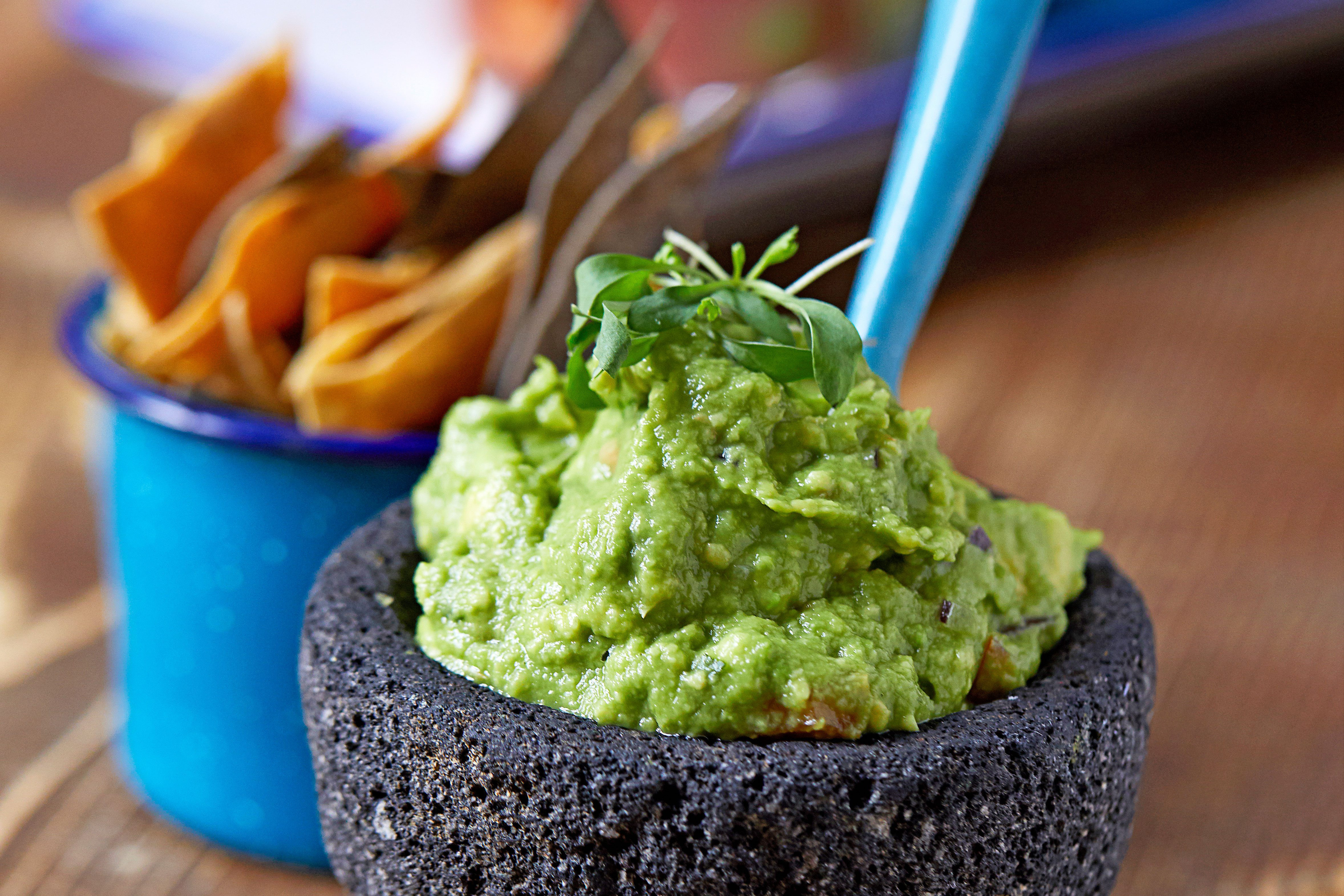 Guacamole in a mortar with a spoon
Guacamole in a mortar with a spoon
10. Tamales: Portable and Delicious
Tamales were first developed for the Aztec, Mayan and Inca tribes who needed nourishing food on the go to take into battle. Pockets of corn dough are stuffed with either a sweet or savoury filling, wrapped in banana leaves or corn husks, then steamed. Fillings vary from meats and cheeses to fruits, vegetables, chillies and mole. Remember to discard the wrapping before eating.
Tamales offer a glimpse into the ingenuity of ancient Mesoamerican cultures. These portable packets of flavor were designed to provide sustenance for warriors on the go, and they remain a popular and delicious food today. With a variety of fillings to choose from, tamales offer a taste of Mexico’s culinary heritage.
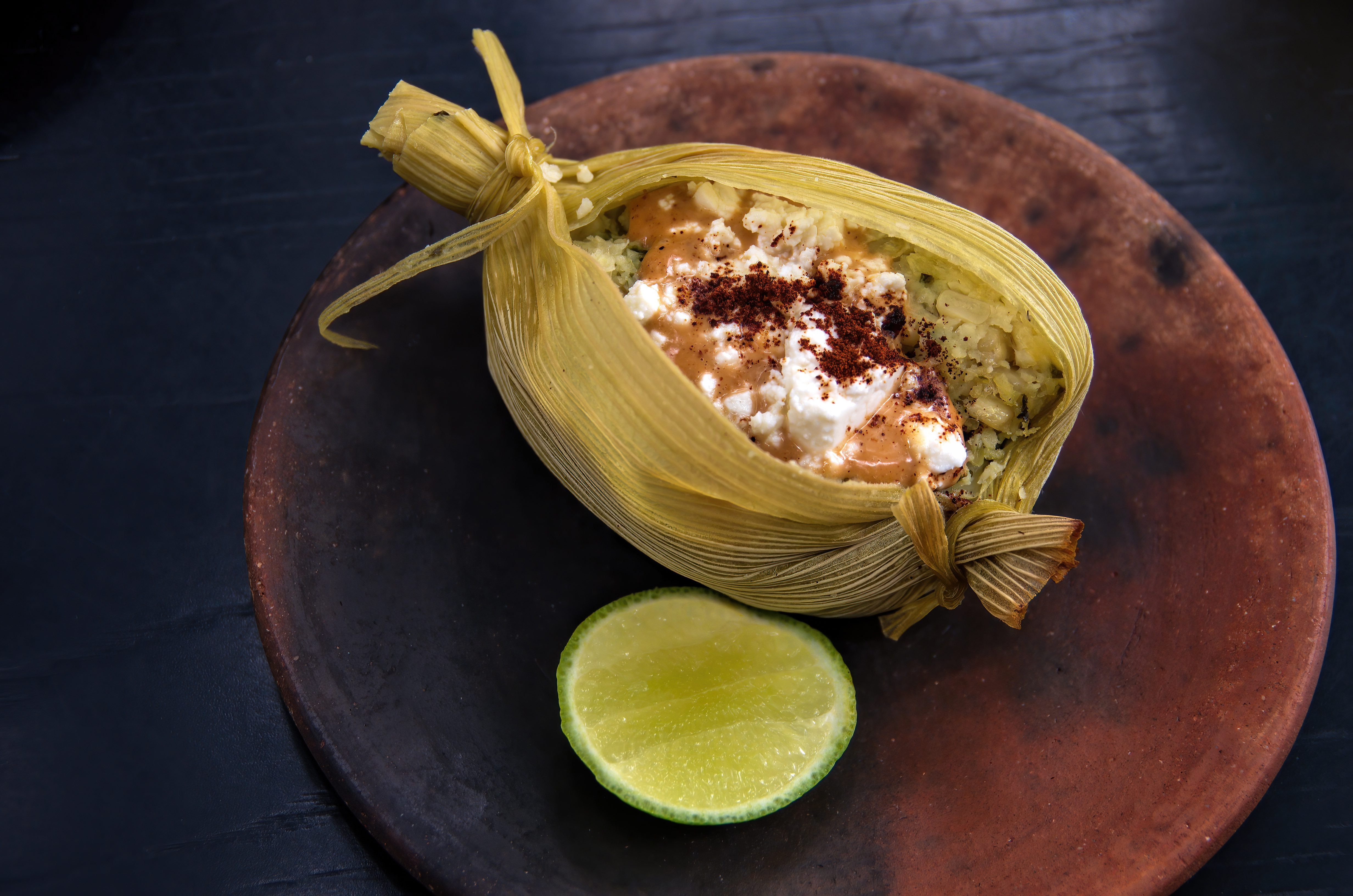 Tamale made from pure corn with chintextle mayonnaise (Oaxacan paste made with chiles) and ranch cheese
Tamale made from pure corn with chintextle mayonnaise (Oaxacan paste made with chiles) and ranch cheese
Understanding Regional Variations in Mexican Cuisine
How does Mexican food vary across different regions of the country?
Mexican cuisine is incredibly diverse, with each region boasting its unique culinary traditions and specialties. From the seafood-rich dishes of the coastal areas to the hearty stews of the highlands, there’s a world of flavors to explore. For instance, Oaxaca is known for its complex mole sauces, while the Yucatan peninsula is famous for its citrus-marinated meats.
Northern Mexico
What are some typical dishes from Northern Mexico?
Northern Mexico is characterized by its beef-centric cuisine, influenced by its proximity to the United States. Some popular dishes include:
- Carne Asada: Grilled beef, often served with tortillas and various toppings.
- Machaca: Dried shredded beef, typically served with eggs for breakfast.
- Burritos: Large flour tortillas filled with meat, beans, and cheese.
Central Mexico
What culinary delights await in Central Mexico?
Central Mexico is the heartland of many iconic Mexican dishes, with a focus on corn-based cuisine and complex flavors. Must-try dishes include:
- Pozole: A hearty soup made with hominy and meat, garnished with various toppings.
- Chiles en Nogada: Poblano peppers stuffed with a mixture of fruits and meats, topped with a walnut cream sauce and pomegranate seeds.
- Barbacoa: Slow-cooked meat, often lamb or goat, traditionally cooked in an underground oven.
Southern Mexico
What flavors define the cuisine of Southern Mexico?
Southern Mexico is known for its vibrant and spicy cuisine, influenced by its indigenous cultures and tropical climate. Some signature dishes include:
- Mole Negro: A dark and complex mole sauce made with chilli peppers, chocolate, and spices.
- Tlayudas: Large, crispy tortillas topped with beans, cheese, meat, and other ingredients.
- Cochinita Pibil: Slow-roasted pork marinated in achiote paste and citrus juices.
Coastal Mexico
What seafood specialties can you find along the Mexican coast?
Mexico’s extensive coastline offers a wealth of fresh seafood, which is showcased in a variety of delicious dishes. Popular coastal dishes include:
- Ceviche: Fresh seafood marinated in lime juice, onions, and chilli peppers.
- Pescado a la Talla: Grilled fish marinated in adobo sauce.
- Tacos de Pescado: Fish tacos, typically made with fried or grilled fish, cabbage, and a creamy sauce.
Essential Ingredients in Mexican Cooking
What are the building blocks of Mexican cuisine?
Mexican cuisine relies on a few key ingredients that form the foundation of its diverse flavors. These include:
- Corn: Used to make tortillas, tamales, and other staple foods.
- Chilli Peppers: Add heat and flavor to a wide range of dishes.
- Beans: A common source of protein, often served as a side dish or used in fillings.
- Avocados: Used to make guacamole and other creamy sauces.
- Limes: Add acidity and brightness to many dishes.
- Onions: Aromatic vegetable used as the base of many dishes.
- Cilantro: Fresh herb used as a garnish and flavoring.
Mexican Street Food: A Culinary Adventure
What are some must-try street foods in Mexico?
Mexican street food is a culinary adventure, offering a wide array of delicious and affordable dishes. Some must-try street foods include:
- Tacos: A variety of fillings served on small corn tortillas.
- Elote: Corn on the cob, typically grilled or boiled and topped with various condiments.
- Esquites: Corn kernels served in a cup with mayonnaise, cheese, and chilli powder.
- Tamales: Corn dough filled with meat, cheese, or vegetables, wrapped in a corn husk or banana leaf.
- Quesadillas: Tortillas filled with cheese and other ingredients, grilled or fried.
Mexican Drinks: From Refreshing to Intoxicating
What beverages should you try in Mexico?
Mexican cuisine is complemented by a variety of refreshing and intoxicating drinks, including:
- Agua Frescas: Refreshing fruit-flavored waters, such as horchata (rice water), jamaica (hibiscus tea), and sandía (watermelon).
- Tequila: A distilled spirit made from the blue agave plant, typically enjoyed neat or in cocktails.
- Mezcal: A distilled spirit made from any type of agave plant, known for its smoky flavor.
- Michelada: A beer cocktail made with lime juice, hot sauce, and spices.
- Atole: A warm, thick drink made from cornmeal, water, and flavorings.
Mexican Desserts: Sweet Endings
What sweet treats does Mexico have to offer?
Mexican desserts are a delightful way to end a meal, offering a variety of flavors and textures. Some popular Mexican desserts include:
- Churros: Fried dough pastries sprinkled with cinnamon and sugar.
- Flan: A creamy custard dessert with a caramel topping.
- Tres Leches Cake: A sponge cake soaked in three kinds of milk.
- Arroz con Leche: Rice pudding flavored with cinnamon and sugar.
- Cajeta: A caramel sauce made from goat’s milk.
Navigating Mexican Cuisine as an LGBTQ+ Traveler
How can LGBTQ+ travelers best enjoy Mexican cuisine?
As an LGBTQ+ traveler, exploring Mexican cuisine can be a rewarding and enriching experience. Here are some tips to help you make the most of your culinary journey:
- Research LGBTQ+-friendly establishments: Look for restaurants and bars that are known for being welcoming and inclusive. Websites like gaymexico.net can provide valuable recommendations.
- Learn some basic Spanish phrases: Knowing a few key phrases can help you communicate with restaurant staff and locals.
- Be open to trying new things: Mexican cuisine is incredibly diverse, so don’t be afraid to step outside your comfort zone and sample new dishes.
- Respect local customs: While Mexico is generally a welcoming country, it’s important to be mindful of local customs and traditions.
- Connect with the local LGBTQ+ community: Consider joining a food tour or cooking class that is organized by or caters to the LGBTQ+ community. This can be a great way to meet new people and learn about Mexican cuisine from a local perspective.
LGBTQ+ Safe Dining in Mexico
Where can LGBTQ+ travelers find welcoming dining experiences?
Many cities and towns in Mexico have established LGBTQ+ scenes with restaurants and bars known for their inclusive atmosphere. Some popular destinations include:
- Puerto Vallarta: Known as one of the most gay-friendly cities in the world, Puerto Vallarta offers a wide range of restaurants and bars that cater to the LGBTQ+ community.
- Mexico City: The capital city has a vibrant LGBTQ+ scene, with many restaurants and bars in the Zona Rosa neighborhood.
- Guadalajara: The second-largest city in Mexico has a growing LGBTQ+ community, with several gay-friendly establishments.
- San Miguel de Allende: This charming colonial town is popular with LGBTQ+ travelers and retirees, with a number of welcoming restaurants and bars.
Gaymexico.net: Your Guide to LGBTQ+ Travel in Mexico
Looking for more information on LGBTQ+ travel in Mexico?
At gaymexico.net, we are committed to providing LGBTQ+ travelers with the information and resources they need to plan safe and enjoyable trips to Mexico. Visit our website to find:
- Comprehensive travel guides: Covering popular destinations and hidden gems throughout Mexico.
- Listings of LGBTQ+-friendly businesses: Including restaurants, bars, hotels, and tour operators.
- Information on LGBTQ+ events and festivals: Happening throughout the year.
- Travel tips and advice: To help you navigate Mexico as an LGBTQ+ traveler.
- Community forums: Where you can connect with other LGBTQ+ travelers and locals.
Address: 3255 Wilshire Blvd, Los Angeles, CA 90010, United States
Phone: +1 (213) 380-2177
Website: gaymexico.net
FAQ about Mexico’s Typical Food
What is the most popular dish in Mexico?
Tacos are arguably the most popular dish in Mexico, with countless variations to suit every taste.
What is a typical Mexican breakfast?
A typical Mexican breakfast might include chilaquiles, huevos rancheros, or tamales, often accompanied by coffee or juice.
What is the spiciest food in Mexico?
Dishes made with habanero peppers, such as salsa habanero or cochinita pibil, are among the spiciest foods in Mexico.
Is Mexican food healthy?
Mexican food can be healthy, especially when it incorporates fresh vegetables, lean proteins, and whole grains.
What is the difference between a taco and a burrito?
A taco is typically made with a small corn tortilla, while a burrito is made with a larger flour tortilla.
What is the most popular Mexican dessert?
Churros are among the most popular Mexican desserts, enjoyed throughout the country and beyond.
What is the best region in Mexico for food?
Each region in Mexico offers unique culinary experiences, making it difficult to choose just one. Oaxaca, Puebla, and the Yucatan Peninsula are all renowned for their distinctive cuisines.
What is the most important meal in Mexico?
Lunch is often considered the most important meal in Mexico, with many businesses closing for a few hours in the afternoon to allow people to enjoy a leisurely meal.
What is the most expensive food in Mexico?
Some of the most expensive foods in Mexico include dishes made with rare or imported ingredients, such as truffles or Wagyu beef.
What is the oldest dish in Mexico?
Tamales are one of the oldest dishes in Mexico, dating back to the Aztec and Mayan civilizations.
Embark on Your Culinary Adventure in Mexico Today
Ready to experience the authentic flavors of Mexico? Visit gaymexico.net for comprehensive travel guides, LGBTQ+-friendly recommendations, and insider tips to help you plan your culinary adventure. Connect with our community, discover hidden gems, and create unforgettable memories in Mexico. Your adventure awaits!

